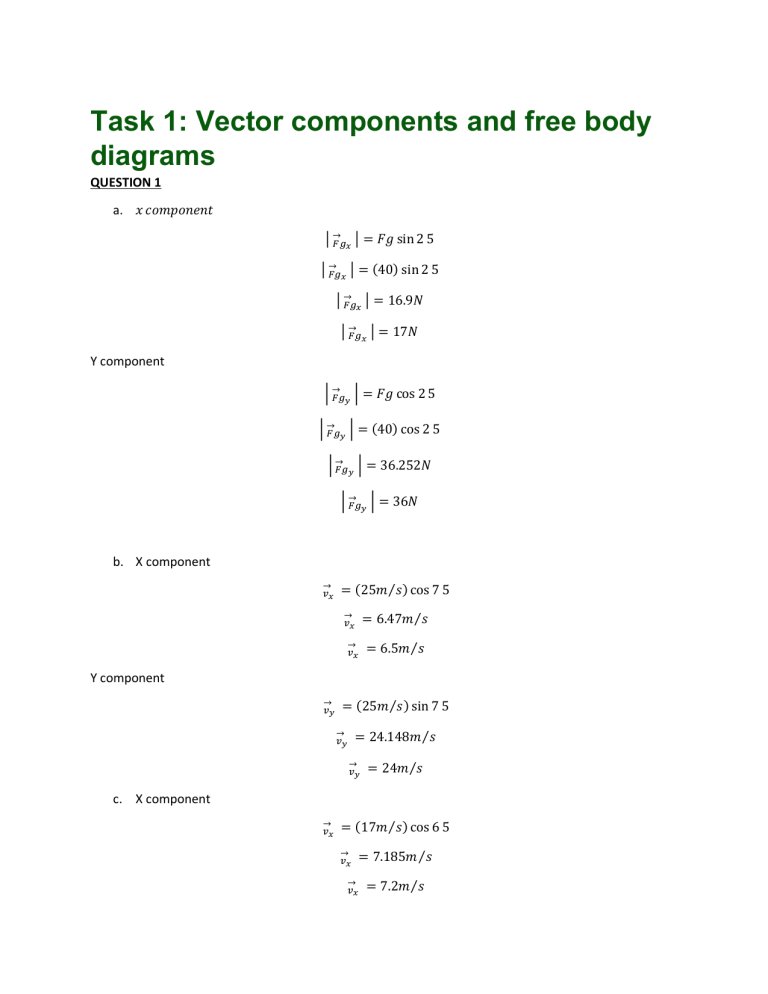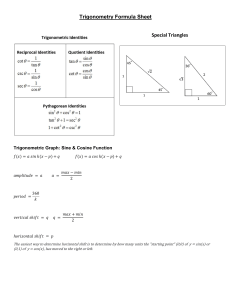
Task 1: Vector components and free body diagrams QUESTION 1 a. 𝑥 𝑐𝑜𝑚𝑝𝑜𝑛𝑒𝑛𝑡 |→ 𝐹𝑔𝑥 | = 𝐹𝑔 sin 2 5 |→ 𝐹𝑔𝑥 | = (40) sin 2 5 |→ 𝐹𝑔𝑥 | = 16.9𝑁 |→ 𝐹𝑔𝑥 | = 17𝑁 Y component |→ 𝐹𝑔𝑦 | = 𝐹𝑔 cos 2 5 |→ 𝐹𝑔𝑦 | = (40) cos 2 5 |→ 𝐹𝑔𝑦 | = 36.252𝑁 |→ 𝐹𝑔𝑦 | = 36𝑁 b. X component → 𝑣𝑥 = (25𝑚⁄𝑠 ) cos 7 5 → 𝑣𝑥 = 6.47𝑚⁄𝑠 → 𝑣𝑥 = 6.5𝑚⁄𝑠 Y component → 𝑣𝑦 = (25𝑚⁄𝑠 ) sin 7 5 → 𝑣𝑦 = 24.148𝑚 ⁄𝑠 → 𝑣𝑦 = 24𝑚⁄𝑠 c. X component → 𝑣𝑥 = (17𝑚⁄𝑠 ) cos 6 5 → 𝑣𝑥 → 𝑣𝑥 = 7.185𝑚 ⁄𝑠 = 7.2𝑚⁄𝑠 Y component → 𝑣𝑦 = (17𝑚⁄𝑠 ) sin 6 5 → 𝑣𝑦 = 15.41𝑚 ⁄𝑠 → 𝑣𝑦 = 15𝑚⁄𝑠 QUESTION 2 a. b. Task 2: Relative velocity and projectile motion problem solving QUESTION 1 a. Let helicopter represent H Let the ground represent G Let airspeed represent A Given: |→ 𝑣𝐻𝐴 | = 42.5𝑚 ⁄𝑠[𝑊] |→ 𝑣𝐴𝐺 | = 25𝑚 ⁄𝑠[𝐸 30°𝑆] Solving for components of |→ 𝑣𝐻𝐴 | |→ 𝑣𝐻𝐴𝑥 | =? |→ 𝑣𝐻𝐴𝑦 | =? Vector falls on east – west horizontal line with no vertical components. Vector only has horizontal → components. Therefore, horizontal component of| → 𝑣𝐻𝐴 |, | 𝑣𝐻𝐴𝑥 | is 42.5 m/s [W] and the vertical → component of | → 𝑣𝐻𝐴 | | 𝑣𝐻𝐴𝑦 | is 0 m/s [S] Solving for components of | → 𝑣𝐴𝐺 | |→ 𝑣𝐴𝐺 | = 25.0𝑚 ⁄𝑠 [𝐸 30° 𝑆] |→ 𝑣𝐴𝐺𝑥 | =? |→ 𝑣𝐴𝐺𝑦 | =? Find the horizontal component using cosine formula |→ 𝑣𝐴𝐺𝑥 | = 𝑣𝑐𝑜𝑠𝜃 |→ 𝑣𝐴𝐺𝑥 | = (25𝑚 ⁄𝑠 ) cos 3 0° |→ 𝑣𝐴𝐺𝑥 | = 21.65𝑚 ⁄𝑠 |→ 𝑣𝐴𝐺𝑥 | = 22𝑚 ⁄𝑠 [𝐸] Find the vertical component using sine formula |→ 𝑣𝐴𝐺𝑦 | = 𝑣𝑠𝑖𝑛𝜃 |→ 𝑣𝐴𝐺𝑦 | = (25𝑚 ⁄𝑠 ) sin 3 0° |→ 𝑣𝐴𝐺𝑦 | = 12.5𝑚 ⁄𝑠 |→ 𝑣𝐴𝐺𝑦 | = 13𝑚 ⁄𝑠 [𝑆] → Therefore, the horizontal component of | → 𝑣𝐴𝐺 |, | 𝑣𝐴𝐺𝑥 | is 22 m/s [E] and the vertical component of → |→ 𝑣𝐴𝐺 | | 𝑣𝐴𝐺𝑦 | is 13 m/s [S] b. Let west and south be positive directions Given: |→ 𝑣𝐻𝐴𝑥 | = 42.5 𝑚 ⁄𝑠 [𝑊] |→ 𝑣𝐴𝐺𝑥 | = 22 𝑚 ⁄𝑠 [𝐸] rounded to 2 significant figures |→ 𝑣𝐴𝐺𝑦 | = 13 𝑚 ⁄𝑠 [𝑆] rounded to 2 significant figures → Required: | → 𝑣𝐻𝐺𝑥 | =? | 𝑣𝐻𝐺𝑦 | =? Solution: To determine | → 𝑣𝐻𝐺𝑥 |, and all given horizontal components. → → |→ 𝑣𝐻𝐺𝑥 | = | 𝑣𝐻𝐴𝑥 | + | 𝑣𝐴𝐺𝑥 | |→ 𝑣𝐻𝐺𝑥 | = 42.5𝑚 ⁄𝑠 + (−22.65𝑚 ⁄𝑠) |→ 𝑣𝐻𝐺𝑥 | = 19.85𝑚 ⁄𝑠 |→ 𝑣𝐻𝐺𝑥 | = 20𝑚 ⁄𝑠 [𝑊] To determine | → 𝑣𝐻𝐺𝑦 |, add all given vertical components. → → |→ 𝑣𝐻𝐺𝑦 | = | 𝑣𝐻𝐴𝑦 | + | 𝑣𝐴𝐺𝑦 | |→ 𝑣𝐻𝐺𝑦 | = 0𝑚 ⁄𝑠 + 12.5𝑚 ⁄𝑠 |→ 𝑣𝐻𝐺𝑦 | = 12.5𝑚 ⁄𝑠 |→ 𝑣𝐻𝐺𝑦 | = 13𝑚 ⁄𝑠 [𝑆] c. Solution: using Pythagorean theorem to find magnitude of resultant velocity 2 2 → → |→ 𝑣𝐻𝐺 | = √ | 𝑣𝐻𝐺𝑥 | + | 𝑣𝐻𝐺𝑦 | 2 2 |→ 𝑣𝐻𝐺 | = √ (19.85𝑚 ⁄𝑠 ) + (12.5𝑚 ⁄𝑠) |→ 𝑣𝐻𝐺 | = √ 550.2725𝑚 ⁄𝑠 |→ 𝑣𝐻𝐺 | = 23.458𝑚 ⁄𝑠 |→ 𝑣𝐻𝐺 | = 23𝑚 ⁄𝑠 Using tangent function to find direction 𝑡𝑎𝑛𝜃 = 𝜃 = tan−1 |→ 𝑣𝐻𝐺𝑦 | |→ 𝑣𝐻𝐺𝑥 | (12.5𝑚⁄𝑠) (19.85𝑚⁄𝑠 ) 𝜃 = 32° Therefore, the resultant velocity of the helicopter relative to the ground is 23 m/s [𝑊32°𝑆] QUESTION 2 Solution: first, determine horizontal and vertical components of initial velocity to help find final velocity which we will use to find the time of flight. Given: → 𝑎 = 9.8 𝑚⁄𝑠 2 [𝑑𝑜𝑤𝑛] △ 𝑑𝑦 = 4.3 𝑚[𝑑𝑜𝑤𝑛] → 𝑣𝑖 = 30 𝑚⁄𝑠 𝜃 = 35° Solving for horizontal components cos 3 5° =→𝑣𝑖𝑥 ⁄ → 𝑣𝑖 → 𝑣𝑖𝑥 → 𝑣𝑖𝑥 → 𝑣𝑖𝑥 =→ 𝑣𝑖 cos 3 5° = (30𝑚⁄𝑠 ) sin 3 5° = 24.575𝑚⁄𝑠 [𝑟𝑖𝑔ℎ𝑡] Solving for vertical components sin 3 5° =→ 𝑣𝑖𝑦 ⁄ → 𝑣𝑖𝑦 = → 𝑣𝑖 → 𝑣𝑖 sin 3 5° → 𝑣𝑖𝑦 = (30𝑚⁄𝑠 ) sin 3 5° → 𝑣𝑖𝑦 = 17.208𝑚⁄𝑠 [𝑢𝑝] a. Required: △ 𝑡 =? → . let up be positive direction Using motion equation 5 to determine 𝑣𝑓𝑦 → 2 𝑣𝑓𝑦 → 𝑣𝑓𝑦 = → 2 𝑣𝑖𝑦 + 2→ 𝑎 △ 𝑑𝑦 = √(17.208𝑚⁄𝑠 )2 + 2(−9.8𝑚⁄𝑠)(−4.3) → 𝑣𝑓𝑦 = √380.395264 → 𝑣𝑓𝑦 = ±19.50𝑚 ⁄𝑠 Negative root chosen since the ball is travelling downward at this time. Therefore, → = −19.50𝑚 ⁄𝑠[𝑢𝑝] 𝑣𝑓𝑦 Solving for time of flight using motion equation 1. → 𝑣𝑓𝑦 → =→ 𝑣𝑖𝑦 +𝑎 △ 𝑡 (−19.50𝑚⁄𝑠 ) = (17.208𝑚⁄𝑠 ) + (−9.8𝑚⁄𝑠 2 △ 𝑡 ) △𝑡= (−36.708𝑚 ⁄𝑠 ) (−9.8𝑚⁄𝑠 2 ) △ 𝑡 = 3.746𝑠 △ 𝑡 = 3.7𝑠 Therefore, the time of flight of the golf ball is 3.7s b. Required: △ 𝑑𝑥 =? Using constant equation for velocity to find range, △ 𝑑𝑥 → 𝑣𝑖𝑥 = △ 𝑑𝑥 △𝑡 → 𝑣𝑖𝑥 △ 𝑑𝑥 = △𝑡 △ 𝑑𝑥 = (24.575𝑚⁄𝑠 )(3.746𝑠) △ 𝑑𝑥 = 92.06𝑚 △ 𝑑𝑥 = 92𝑚 Therefore, the range for the golf ball is 92m. c. Required: → 𝑣𝑓 =? Using Pythagorean theorem to solve for final velocity 2 2 → → |→ 𝑣𝑓 | = √| 𝑣𝑓𝑥 | + | 𝑣𝑓𝑦 | 2 2 |→ 𝑣𝑓 | = √(24.575𝑚 ⁄𝑠 ) + (19.50𝑚 ⁄𝑠) |→ 𝑣𝑓 | = ±31.371𝑚 ⁄𝑠 Choose a positive root since magnitude is always positive |→ 𝑣𝑓 | = 31𝑚 ⁄𝑠 Using tangent function to determine direction 𝑡𝑎𝑛𝜃 = 𝑣𝑓𝑦 ⁄ → 𝑣𝑓𝑥 → 𝜃 = tan−1 (19.50𝑚⁄𝑠 ) (24.575𝑚⁄𝑠 ) 𝜃 = 38° Therefore, the velocity of the golf ball the instant before the ball impacts the ground is 31 𝑚⁄𝑠 [𝑟𝑖𝑔ℎ𝑡 38° 𝑑𝑜𝑤𝑛] Task 3: Newton’s laws of motion and uniform circular motion problem-solving QUESTION 1 a. b. → 𝐹𝑛𝑒𝑡𝑦 = → 𝐹𝑛 + (−→ 𝐹𝑔𝑦 ) All force is happening on x-axis, therefore movement on the y-axis. → 𝐹𝑛𝑒𝑡𝑦 = 0 because acceleration is 0 since there is no 0 = 𝐹𝑁 − 𝑚𝑔 cos 3 0° 𝐹𝑁 = 𝑚𝑔 cos 3 0° 𝐹𝑁 = (120𝑘𝑔)(9.8𝑚⁄𝑠 2 ) cos 3 0° 𝐹𝑁 = 1018.45𝑘𝑔 [𝑢𝑝] 𝐹𝑁 = 1.0 × 103 𝑘𝑔 [𝑢𝑝] c. Solution → 𝐹𝑘 = 𝜇𝑘 𝐹𝑁 → (0.10)(1018.45𝑘𝑔) 𝐹𝑘 = → 𝐹𝑘 = 101.845𝑁 → 𝐹𝑘 = 1.0 d. Solution for 𝐹𝑛𝑒𝑡𝑥 × 102 𝑁 𝐹𝑛𝑒𝑡𝑥 = 𝐹𝑔𝑥 + (−𝐹𝑘) 𝐹𝑛𝑒𝑡𝑥 = (𝑚𝑔) sin 3 0° − 101.845𝑁 𝐹𝑛𝑒𝑡𝑥 = (120𝑘𝑔)(9.8𝑚⁄𝑠 2 ) sin 3 0° − 101.845𝑁 𝐹𝑛𝑒𝑡𝑥 = 588𝑁 − 101.845𝑁 𝐹𝑛𝑒𝑡𝑥 = 486.155𝑁 Solving for acceleration → 𝐹𝑛𝑒𝑡𝑥 = 𝑚𝑎→𝑥 486.155𝑁 = (120𝑘𝑔)𝑎𝑥 𝑎𝑥 = 486.155𝑁 120𝑘𝑔 𝑎𝑥 = 4.05𝑚⁄𝑠 2 [𝑑𝑜𝑤𝑛 𝑡ℎ𝑒 𝑟𝑎𝑚𝑝] Therefore, the acceleration of the piano down the ramp along the axis parallel to the ramp is 4.05𝑚 ⁄𝑠 2 [𝑑𝑜𝑤𝑛 𝑡ℎ𝑒 𝑟𝑎𝑚𝑝] QUESTION 2 a. Given: m=100kg, r=0.25m Required: v=? Solution: using equation to determine minimum speed required to maintain the path of circular motion v=√𝑟𝑔 𝑣 = √(0.25)(9.8𝑚⁄𝑠 2 ) 𝑣 = ±1.565𝑚 ⁄𝑠 Choose positive root since magnitude is always positive 𝑣 = 1.57𝑚⁄𝑠 (Rounded to 3 significant figures) b. Given: r = 0.25m, m=0.100kg, v= 1.57m/s g= 9.8m/s^2 Required: 𝐹𝑇 =? 𝐹𝐶 = 𝐹𝑇 − 𝐹𝑔 𝑣2 𝑚 ( ) = 𝐹𝑇 − 𝑚𝑔 𝑟 𝐹𝑇 = (0.100𝑘𝑔)(1.57𝑚⁄𝑠 2 ) + 𝑚𝑔 0.25𝑚 𝐹𝑇 = 0.97969 + 0.98 𝐹𝑇 = 1.959𝑁 𝐹𝑇 = 2.0𝑁 Therefore, thew magnitude of the tension in the string at the bottom of the circle is 2.0N QUESTION 3 a. Given: 𝐹𝐾 = 5.0𝑁 𝑚1 = 2.1𝑘𝑔 𝑚2 = 3.3𝑘𝑔 Solving for acceleration using Newton’s Second Law 𝐹𝑛𝑒𝑡 = 𝑚𝑎 𝑎= 𝑎= 𝐹𝑛𝑒𝑡 𝑚 𝐹𝑇 − 𝐹𝑘 + 𝑚2 𝑔 − 𝐹𝑇 (𝑚1 + 𝑚2 ) 𝑎= 𝑎= 𝑚2 𝑔 − 𝐹𝑘 (𝑚1 + 𝑚2 ) 32.34𝑁 − 5.0𝑁 5.4𝑘𝑔 𝑎 = 5.06𝑚⁄𝑠 2 To solve for 𝐹𝑇 Solve for 𝑚1 𝐹𝑛𝑒𝑡1 = 𝐹𝑇 − 𝐹𝑘 𝑚1 𝑎 = 𝐹𝑇 − 𝐹𝑘 𝐹𝑇 = (2.1𝑘𝑔)(5.06𝑚 ⁄𝑠 2 ) + 5.0𝑁 𝐹𝑇 = 15.626𝑁 𝐹𝑇 = 16𝑁 Therefore 𝐹𝑇 = 16𝑁 . For verification, solve for 𝑚2 to see if 𝐹𝑇 will have same outcome has 𝑚1 b. Solving for 𝑚2 𝐹𝑛𝑒𝑡2 = 𝐹𝑔2 − 𝐹𝑇 𝑚2 𝑎 = 𝑚2 𝑔 − 𝐹𝑇 𝐹𝑇 = 𝑚2 𝑔 − 𝑚2 𝑎 𝐹𝑇 = (3.3𝑘𝑔)(9.8𝑚⁄𝑠 2 ) − (3.3𝑘𝑔)(5.06𝑚⁄𝑠 2 ) 𝐹𝑇 = 32.34𝑁 − 16.698𝑁 𝐹𝑇 = 15.642𝑁 𝐹𝑇 = 16𝑁 Therefore, the magnitude of the tension in the string is 16N



